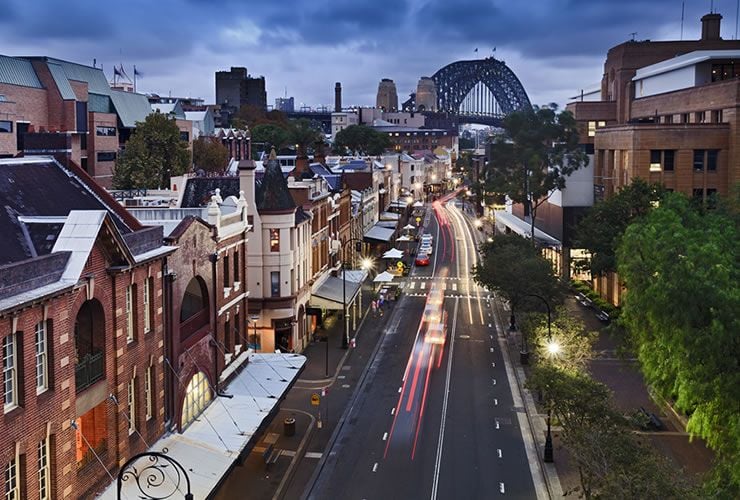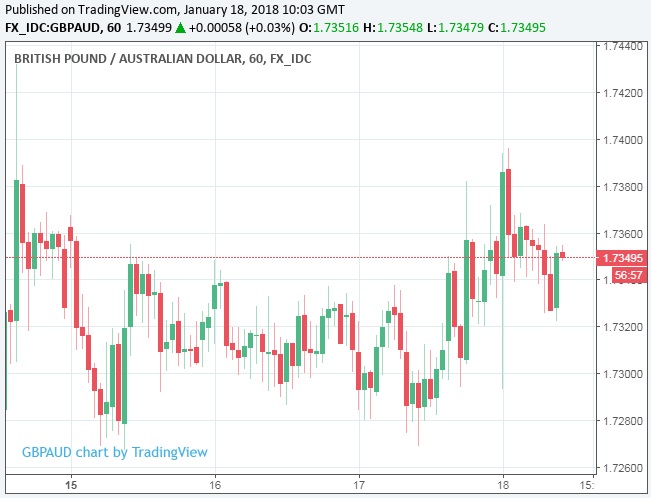Australian Dollar Boosted by “Phenomenal” Jobs Market and Strong Chinese Economic Performance
- Written by: James Skinner

Australia's labour market created jobs at twice the pace of population growth in 2017, which has implications for the Reserve Bank of Australia and interest rates.
The Australian Dollar edged higher against many of its G10 rivals during early trading in London Thursday as markets responded to a “phenomenal year” for the Australian labour market and better than expected Chinese economic growth.
Australia’s economy created 34,700 new jobs during December, according to Australian Bureau of Statistics data released in the early hours, which was far ahead of the economist consensus for just 13,200 new jobs to have been created.
“The final employment report of 2017 completed a phenomenal calendar year of monthly labour force releases. The big lift in employment over December once again bettered consensus. And once again the underlying detail was robust,” says Gareth Aird, a senior economist at Commonwealth Bank of Australia.
Thursday’s data follows a series of exceptionally strong labour market reports and has pushed the three month rolling average for job creation up to 35,500 per month.
Overall employment growth was 3.3% in 2017, twice the rate of population growth according to some economists.
“Labour market outcomes in 2018 will be critical to the timing of any potential move in the cash rate,” Aird adds.
“Wages growth should gradually lift as underutilisation continues to recede (both unemployment and underemployment are expected to grind lower). And this should put some mild upward pressure on inflation and inflation expectations. As such, a first rate rise since 2010 looks probable this year.”
On the downside, the Australian unemployment rate rose 10 basis points to 5.5%, although some say this is nothing for observers to be concerned about.
“The rise in the unemployment rate is actually a positive sign for the Australian labor market,” remarks Marshall Gittler, chief strategist at ACLS Global.
“That’s because it’s due to a rise in the participation rate. It means people are getting more confident about the labor market and so some people who were previously on the sidelines have decided to look for work. That’s good for the economy.”
Australia's Dollar traded higher against the US Dollar, Canadian Dollar and Japanese Yen Thursday morning, but ceded ground to a stronger Euro, Sterling and Swiss Franc.
This saw the AUD/USD rate quoted 0.07% higher at 0.7977 while the Pound-to-Australian-Dollar rate was quoted 0.03% higher at 1.7348.

Above: Pound-to-Australian-Dollar rate shown at hourly intervals.
Advertisement
Get up to 5% more foreign exchange by using a specialist provider to get closer to the real market rate and avoid the gaping spreads charged by your bank when providing currency. Learn more here.
The labour report comes after Wednesday’s home loans data showed mortgage lending rising by 2.1% during November, which was in contrast to economist expectations for a 0.1% fall.
Mortgage lending has been expected to slow after authorities tightened up mortgage lending rules last year, in the name of “financial stability”.
Retail sales also came in much stronger than was expected for November although it remains unclear how much of this was due to the Black Friday sales and the launch of the new iPhone.
Separately, and also on Thursday, the Chinese economy was shown growing at a faster than expected pace during the final quarter of 2017.
The world’s second largest economy expanded at a rate of 6.8%, which is unchanged from the rate of growth seen in the third quarter but faster than the 6.7% expansion forecast by economists.
More importantly for Australia, Chinese fixed asset investment and industrial production were also shown growing at a faster than expected pace in December, suggesting the slowdown in Chinese demand for hard commodities that some have feared is yet to materialise.
RBA and Australian Dollar Forecasts Mixed
All of the above matters for the Australian Dollar because of the implications that commodity demand, consumer spending and jobs growth have for the economy and therefore, inflation and interest rates.
The Reserve Bank of Australia has held the official cash rate at a record low of 1.5% ever since August 2016. It has been content to hold rates where they are due to below-target inflation, weak wage growth and concerns that rising interest rates might tip some highly indebted Aussie households over the edge.
Pricing in interest rate derivatives markets suggests there is a 50% chance of a rate hike from the Reserve Bank of Australia before 2018.
Aird and the Commonwealth team forecast an initial interest rate rise in the fourth quarter, closer toward the end of the year.
Canadian investment bank TD Securities is even more bullish, suggesting the RBA might move as early as May 2018 if February's wages report shows pay pressures beginning to build in Australia.
“This is not a central bank that is looking to remain sidelined for an extended period of time as the rates market has it priced. The catalyst for a reprice may not come until February with RBA meeting/wages scheduled,” writes Mazen issa, a senior fx strategist at TD Securities, in a recent note.
But not everybody is as optimistic.
“We continue to expect the RBA to remain on hold in the year ahead. This means that a negative policy rate spread between Australia and the US looks almost certain in 2018,” says Sally Auld, chief economist for Australia and New Zealand at J.P. Morgan, in a recent currency briefing.
Pricing in interest rate derivatives markets, which enable investors to protect themselves against changes in interest rates, currently suggests the RBA will raise rates around the end of 2018. But few analysts have put pen to paper and called for a rate hike this year.
"While rate differentials have seemingly lost some of their pull on currencies of late, we still think that this development should have some influence on the path of AUD/USD," Auld explains.
If the Reserve Bank of Australia continues to hold off on raising rates, while the Federal Reserve and other central banks continue to normalise their monetary policies, then the Australian Dollar could be hit hard during the year ahead.
“In 2018, we expect AUD’s ranking within the G10 to slip a few places; we are forecasting a steady decline towards USD0.72 by year end,” Auld notes.
Australian government bonds have traditionally paid a higher yield than that offered by other developed world bonds but, if the above interest rate dynamics play out, then this yield premium will shrink. It may even become negative.
This would drive international money flows away from the Aussie Dollar, leading to downward pressure on Aussie exchange rates.
Readers can learn more about what other strategists say 2018 has in store for the Australian Dollar here; Compilation of Major Bank Forecasts, Currency Views.
Advertisement
Get up to 5% more foreign exchange by using a specialist provider to get closer to the real market rate and avoid the gaping spreads charged by your bank when providing currency. Learn more here.




